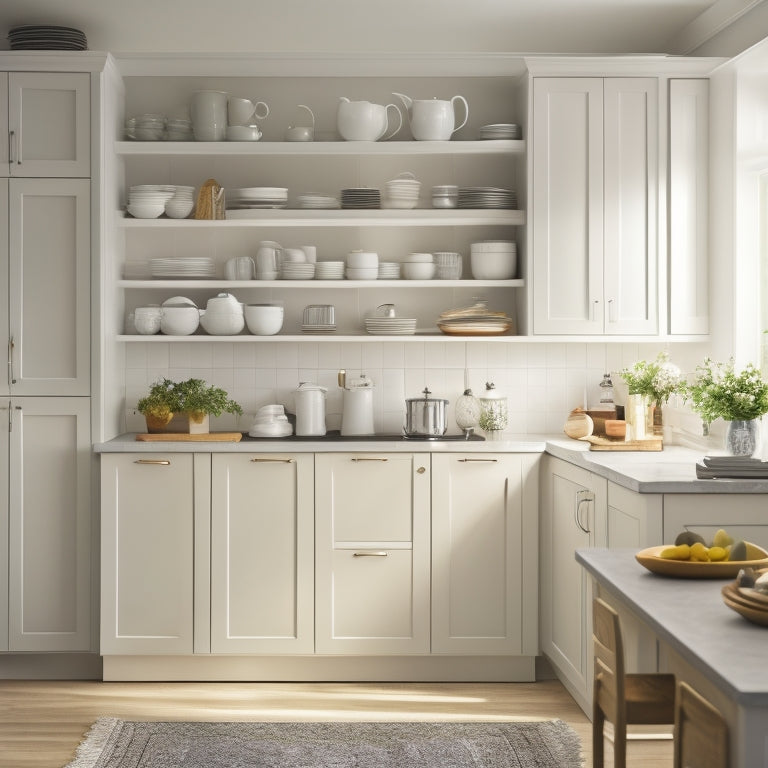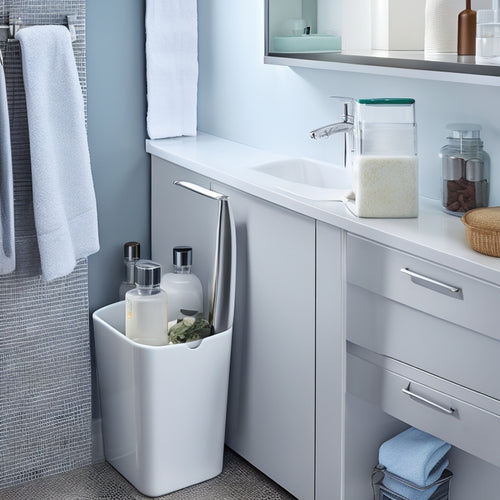
5 Simple Steps to Organized Kitchen Cupboards
Share
You'll transform your cluttered kitchen cupboards into organized havens by following these 5 simple steps. First, purge and declutter your cupboard contents, sorting items into categories and ditching expired or broken ones. Next, categorize and group similar items together, creating a visual hierarchy that makes sense for your kitchen. Then, assign a home for each item, dividing your kitchen into zones and using labeling systems. After that, utilize storage containers effectively, maximizing capacity and labeling them for easy identification. Finally, maintain your organized space by tidying up regularly and scheduling deep cleaning sessions. Now, take the next step...
Key Takeaways
• Remove everything from cupboards, sort items into categories, and purge expired or broken items to create a clean slate for organization.
• Categorize and group similar items together, establishing frequency zones and a visual hierarchy to maximize kitchen space and ease of use.
• Assign a specific home for each item, dividing the kitchen into zones and using labeling systems to ensure frequently used items are easily accessible.
• Utilize storage containers effectively by maximizing capacity, using snug-fitting containers, and labeling for easy identification, keeping similar items neatly stored.
• Set aside time weekly for maintenance, tidying up cluttered areas, and putting things back in designated spots to maintain the organized space.
Purge and Declutter Cupboard Contents
Start by removing everything from your kitchen cupboards, sorting items into categories, and getting rid of anything expired, broken, or no longer useful. This step is important in adopting a decluttering mindset, a fundamental aspect of kitchen psychology.
It's vital to acknowledge that clutter can affect your mental and emotional well-being, making it harder to focus and be productive in the kitchen.
As you sort through your cupboards, be honest with yourself about each item. When was the last time you used it? Do you still have a purpose for it? Be ruthless – if you haven't used it in the past year, it's likely you won't miss it.
Remove any duplicates, broken items, or things that no longer serve a purpose. This process may take some time, but it's valuable.
You'll be left with a clean slate, ready to organize your remaining items in a way that makes sense for your kitchen and your needs. By letting go of the unnecessary, you'll create a more peaceful and functional kitchen space that inspires creativity and joy.
Categorize and Group Similar Items
Now that you've purged your cupboards of unnecessary items, categorize and group similar items together, such as baking supplies, cooking utensils, or dinnerware, to create a sense of order and make the most of your kitchen space. This step is vital in establishing a functional and organized kitchen. By grouping similar items, you'll be able to see what you have, making it easier to find what you need when you need it.
Create Frequency Zones by categorizing items based on how often you use them. Place frequently used items in easy-to-reach zones, while less frequently used items can be stored in harder-to-reach areas. This will save you time and energy in the long run.
Establish a Visual Hierarchy by grouping similar items together and arranging them in a logical order. For example, group all your baking supplies, such as flour, sugar, and baking powder, together on one shelf. This will create a sense of order and make it easier to navigate your kitchen.
Assign a Home for Each Item
You'll need to designate a specific spot for each item in your kitchen, ensuring that everything has a clear and convenient place to reside. This is where the concept of 'a home for each item' comes in. By assigning a specific spot for each item, you'll create a sense of order and structure in your kitchen.
Here are some key considerations to keep in mind:
-
Zone Designation: Divide your kitchen into zones, such as baking, cooking, and storage, to create a logical flow of items.
-
Labeling Systems: Use labels or signs to identify where each item belongs, making it easy to find what you need when you need it.
-
Frequency of Use: Store frequently used items in easy-to-access locations, and less frequently used items towards the back or on higher shelves.
-
Category Grouping: Group similar items together, such as all baking supplies in one area, to create a sense of cohesion.
-
Personal Preference: Consider your personal preferences and habits when assigning a home for each item, making it more likely that you'll stick to the system.
Utilize Storage Containers Effectively
By assigning a home for each item, you've laid the groundwork for a more organized kitchen, and now it's time to maximize storage capacity by utilizing containers that keep similar items neatly stored and easily accessible.
To optimize shelving, use containers that fit snugly on your shelves, leaving minimal gaps. This will help prevent clutter from building up again. Label each container so you can quickly identify what's inside. This is especially helpful for containers holding small items like spices or baking supplies.
Here are some container suggestions for common kitchen items:
| Item Type | Container Suggestion |
|---|---|
| Baking Supplies | Stackable plastic bins with lids |
| Spices | Small, rectangular containers with dividers |
| Snacks | Clear, airtight containers with handles |
| Cooking Utensils | Hanging organizer with pockets |
| Pantry Staples | Large, sealed containers with wheels |
Maintain Your Organized Space
Every week, set aside 10-15 minutes to maintain your organized kitchen cupboards by tidying up cluttered areas and ensuring everything remains in its assigned home. This habit will help you stay on top of clutter and keep your kitchen running smoothly.
By incorporating this daily routine into your habit formation, you'll find that maintaining your organized space becomes second nature.
Here are some tips to help you maintain your organized kitchen cupboards:
-
Put things back: After using an item, return it to its designated spot to avoid clutter buildup.
-
Clean as you go: Wipe down countertops and tidy up spills immediately to prevent crumbs and stains from setting in.
-
Check expiration dates: Regularly inspect your pantry and fridge for expired items and dispose of them accordingly.
-
Restock and refill: Replenish supplies and refill containers as needed to maintain a sense of abundance and order.
-
Schedule a deep clean: Set a reminder to deep clean your kitchen every 2-3 months to tackle any areas that need extra attention.
Frequently Asked Questions
How Often Should I Clean My Kitchen Cupboards to Maintain Organization?
While dust bunnies multiply and crumbs accumulate, you're left wondering: how often should I clean my kitchen cupboards? Incorporate daily schedules for wiping down shelves and seasonal purges to maintain organization and a sense of calm in your kitchen haven.
Can I Use Baskets or Only Plastic Storage Containers?
You can definitely use baskets as an alternative to plastic storage containers, opting for wicker alternatives or decorative holders that add a touch of warmth and style to your kitchen while keeping items organized.
What if I Have Limited Cupboard Space for Storage?
If you're dealing with limited cupboard space, don't worry! You can still maximize storage with compact designs and space savers like stackable containers, hanging organizers, or shelves that'll help you make the most of your available space.
Are Adjustable Shelving Units Worth the Investment?
You're wondering if adjustable shelving units are worth the investment. They offer shelf customization, allowing you to maximize your limited space, and their versatility can justify the cost, making them a valuable addition to your kitchen.
Can I Involve My Family Members in the Organization Process?
"You're brave, thinking you can tame the chaos with your family's help! Involve them, and you'll spark Family Motivation and Team Building. Assign tasks, and watch them bond over a clutter-free kitchen - it's a miracle!"
Related Posts
-

Community Engagement: Learning Through Professions
Community engagement is a powerful tool for fostering a deeper understanding of various professions among children. B...
-

Revamp Your Under-Sink Setup Like a Pro
To revamp your under-sink setup like a pro, start by evaluating your space and categorizing existing items, taking no...

